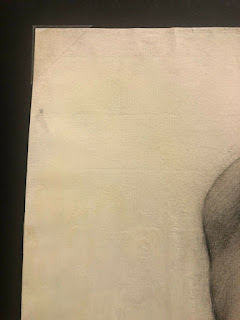A seller on eBay has listed this beautiful fully restored academic study of a male nude attributed to Parisian artist Victor de Grailly from the latter part of the 19th century. Apparently the seller, like myself, took the time and expense to have the drawing fully restored by a paper conservator which in itself shows a great appreciation for the artistic talent of Victor de Grailly and the value of preserving these lesser known works of art. I have posted the content of his listing regarding his efforts to bring this beautiful work of art back to its original condition. Here is his description of the work and the paper conservation efforts:
"This drawing was purchased from an Etsy shop, described as an unidentified American artist. The drawing suffered from numerous tears and stains, all fairly divulged by the seller. I purchased the drawing and undertook substantial repairs on the paper, 95% of which were outside of the figure. The right leg proper of the figure was badly damaged below the knee. Look closely, you will see an area between the foot and knee that outlines, roughly, a circle of loss that has been filled.
On the left side, the tears and stains were filled and smoothed out. You’ll see that on this side, the color of the paper is slightly different. This was due to the process of smoothing out the tone of the paper evenly, while doing the least amount of work necessary to eliminate major distractions.
Again, the figure itself was nearly untouched, except for the right leg proper.
The drawing bears the initials “VG,” which are for the French 19th-century academic artist, Victor de Grailly. Grailly was born in Paris in 1804. He later studied with Victor Bertin, another well-known French artist. Later, Grailly began making paintings of American landscapes based on engravings from books, which he successfully sold. His paintings mimicked Hudson River School scenes. However, it is not clear that Victor de Grailly ever came to America.
De Grailly’s connection to the American art market explains how this drawing would have made its way to the States. An American buyer in Paris, buying Graillys to sell back home, could have bought it and brought it back. Alternately, an American—man or woman--doing the “Grand Tour” may have been captivated by the beauty of this drawing and bought it. It appears to never have been framed—no mat burn, no nail marks, tape marks, nothing. Typical of American prudery, which seems to have known no bounds, the drawing was likely hidden away and the true author of the drawing forgotten.
This is an extraordinary drawing by a more-than-capable artist. While de Grailly’s landscapes continue to sell at auction, they do not command huge prices. His forte seemed to have been drawing. Alas, there was no market for this work in 19th century America, and very little market for it in Europe. This lot comes with a 1974 issue of The Magazine Antiques which profiles de Grailly in a long article, with images of paintings from the numerous collections he is in."
****
Here are some additional biographical notes regarding the artist:
Born in Paris, France in 1804, Victor de Grailly executed many paintings of American scenes, using William Henry Bartlett’s engravings in his book, American Scenery (London, 1840) as a source of inspiration for a subject he truly loved. It is believed that he came to the United States and visited the Hudson River, though this is difficult to confirm. De Grailly studied under Victor Bertin, who gave him a neo-classical foundation for his landscapes. As de Grailly’s style developed, he adopted a more romantic approach, though the formal balance and traditional compositions of his neo-classical roots remained. He first exhibited at the Paris Salon of 1833 and continued to show his work there until late in his life.
His work is held in the permanent collection of the New York Historical Society and the Brooklyn Museum of Art in New York, NY; the Baltimore Museum of Art, Baltimore, MD; The White House, Washington, DC; and the West Point Museum, West Point, NY.
De Grailly learned his craft under the French artist Jean Victor Bertin. At the Salon from 1830 to 1880, he regularly exhibited landscapes in the manner of, or as direct copies from, seventeenth-century Dutch masters. Copies by him of Van Ruisdael and Hobbema are known. De Grailly’s most successful works, however, have been the execution of parlor-sized canvases after engravings of William Henry Bartlett’s views of the eastern United States in American Scenery, published in England in 1838. Though there is no reason to think that De Grailly ever left his native country, such a number of the American views after Bartlett are in this country, often several representations of the same scene, that one wonders whether there was an outlet for his work in the United States
--------------------------------------
Here is a sampling of his well listed Hudson River paintings:

































